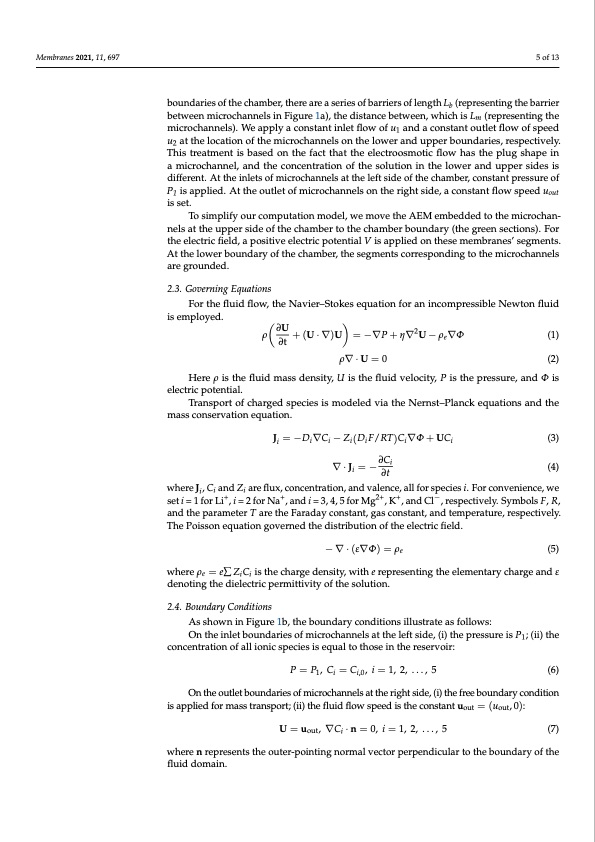
PDF Publication Title:
Text from PDF Page: 005
Membranes 2021, 11, 697 5 of 13 boundaries of the chamber, there are a series of barriers of length Lb (representing the barrier between microchannels in Figure 1a), the distance between, which is Lm (representing the microchannels). We apply a constant inlet flow of u1 and a constant outlet flow of speed u2 at the location of the microchannels on the lower and upper boundaries, respectively. This treatment is based on the fact that the electroosmotic flow has the plug shape in a microchannel, and the concentration of the solution in the lower and upper sides is different. At the inlets of microchannels at the left side of the chamber, constant pressure of P1 is applied. At the outlet of microchannels on the right side, a constant flow speed uout is set. To simplify our computation model, we move the AEM embedded to the microchan- nels at the upper side of the chamber to the chamber boundary (the green sections). For the electric field, a positive electric potential V is applied on these membranes’ segments. At the lower boundary of the chamber, the segments corresponding to the microchannels are grounded. 2.3. Governing Equations For the fluid flow, the Navier–Stokes equation for an incompressible Newton fluid is employed. ∂U 2 ρ ∂t +(U·∇)U =−∇P+η∇ U−ρe∇Φ (1) ρ∇ · U = 0 (2) Here ρ is the fluid mass density, U is the fluid velocity, P is the pressure, and Φ is electric potential. Transport of charged species is modeled via the Nernst–Planck equations and the mass conservation equation. Ji = −Di∇Ci − Zi(DiF/RT)Ci∇Φ + UCi (3) ∇·Ji =−∂Ci (4) ∂t where Ji, Ci and Zi are flux, concentration, and valence, all for species i. For convenience, we set i = 1 for Li+, i = 2 for Na+, and i = 3, 4, 5 for Mg2+, K+, and Cl−, respectively. Symbols F, R, and the parameter T are the Faraday constant, gas constant, and temperature, respectively. The Poisson equation governed the distribution of the electric field. −∇·(ε∇Φ) = ρe (5) where ρe = e∑ ZiCi is the charge density, with e representing the elementary charge and ε denoting the dielectric permittivity of the solution. 2.4. Boundary Conditions As shown in Figure 1b, the boundary conditions illustrate as follows: On the inlet boundaries of microchannels at the left side, (i) the pressure is P1; (ii) the concentration of all ionic species is equal to those in the reservoir: P = P1, Ci = Ci,0, i = 1, 2, . . . , 5 (6) On the outlet boundaries of microchannels at the right side, (i) the free boundary condition is applied for mass transport; (ii) the fluid flow speed is the constant uout = (uout, 0): U = uout, ∇Ci · n = 0, i = 1, 2, . . . , 5 (7) where n represents the outer-pointing normal vector perpendicular to the boundary of the fluid domain.PDF Image | Brines Based on Free Flow Ion Concentration Polarization

PDF Search Title:
Brines Based on Free Flow Ion Concentration PolarizationOriginal File Name Searched:
membranes-11-00697-v2.pdfDIY PDF Search: Google It | Yahoo | Bing
Product and Development Focus for Infinity Turbine
ORC Waste Heat Turbine and ORC System Build Plans: All turbine plans are $10,000 each. This allows you to build a system and then consider licensing for production after you have completed and tested a unit.Redox Flow Battery Technology: With the advent of the new USA tax credits for producing and selling batteries ($35/kW) we are focussing on a simple flow battery using shipping containers as the modular electrolyte storage units with tax credits up to $140,000 per system. Our main focus is on the salt battery. This battery can be used for both thermal and electrical storage applications. We call it the Cogeneration Battery or Cogen Battery. One project is converting salt (brine) based water conditioners to simultaneously produce power. In addition, there are many opportunities to extract Lithium from brine (salt lakes, groundwater, and producer water).Salt water or brine are huge sources for lithium. Most of the worlds lithium is acquired from a brine source. It's even in seawater in a low concentration. Brine is also a byproduct of huge powerplants, which can now use that as an electrolyte and a huge flow battery (which allows storage at the source).We welcome any business and equipment inquiries, as well as licensing our turbines for manufacturing.| CONTACT TEL: 608-238-6001 Email: greg@infinityturbine.com | RSS | AMP |